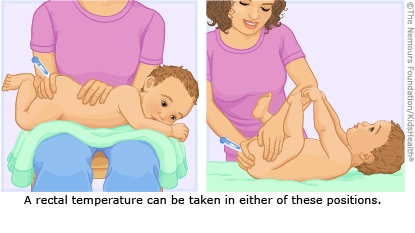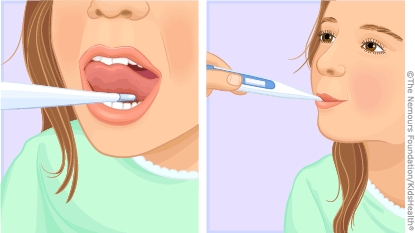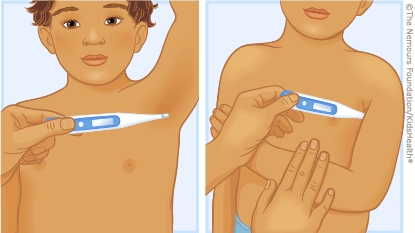All kids get a fever from time to time. A fever itself usually causes no harm and can actually be a good thing — it's often a sign that the body is fighting an infection. But a high fever sometimes is a sign of a problem that needs your doctor's attention.
What Types of Thermometers Are Available?
Digital Thermometers
Digital thermometers give the quickest, most accurate readings, and are the only kind that doctors currently recommend. Available in a variety of sizes and shapes, they're sold at most supermarkets and drugstores.
Read the manufacturer's instructions to see what the thermometer is designed for and how it signals that the reading is complete.
Digital thermometers are used for these temperature-taking methods:
- rectal (in the bottom) — most accurate method for children under 3 years old
- oral (in the mouth) — best for kids 4–5 years or older who can cooperate
- axillary (under the arm) — the least accurate digital thermometer, but good for a first check
Other Types of Thermometers
- temporal artery thermometers — these measure heat waves on side of forehead and can be used in infants 3 months and older
- electronic ear (tympanic) thermometers — these measure heat waves from the eardrum and can be used in infants 6 months and older
Types Not Recommended
These types of thermometers aren't recommended because they're less accurate:
- plastic strip thermometers
- pacifier thermometers
- smartphone temperature apps
Glass mercury thermometers were once common, but should not be used because of possible exposure to mercury, an environmental toxin.
Tips for Taking Temperatures by Age
As any parent knows, taking a squirming child's temperature can be a challenge. The best method will depend on a child's age and temperament.
Turn on the digital thermometer and clear the screen of any old readings. Digital thermometers usually have a plastic, flexible probe with a temperature sensor at the tip and an easy-to-read digital display on the other end. If your thermometer uses disposable plastic sleeves or covers, put one on according to the manufacturer's instructions. Throw away the sleeve afterward and clean the thermometer according to the manufacturer's instructions before putting it back in its case.
For babies younger than 3 months, you'll get the most reliable reading by using a digital thermometer to take a rectal temperature. Call the doctor if your infant is younger than 3 months old and has a temperature of 100.4°F (38°C) or higher.
For babies between 3 months and 6 months old, a digital rectal thermometer is still the best choice. A temporal artery thermometer also can be used.
For kids between 6 months and 4 years old, you can use a digital thermometer to take a rectal temperature. You also can use an tympanic (ear) thermometer or a digital thermometer to take an axillary (armpit) temperature, but they're less accurate.
For kids 4 years or older, you can usually use a digital thermometer to take an oral temperature if your child will cooperate. But kids who are coughing a lot or breathing through their mouths because of stuffy noses might not be able to keep their mouths closed long enough for an accurate oral reading. In these cases, you can use the temporal, tympanic, rectal, or axillary method (with a digital thermometer).
How Do I Take a Rectal Temperature?
Before becoming parents, most people cringe at the thought of taking a rectal temperature. But don't worry — it's a simple and safe process.
First:
- Wash the end of the thermometer with soap and water and rinse with water.
- Moisten the tip of the thermometer with a lubricant, such as petroleum jelly.

Then, place your child:
- belly-down across your lap or on a firm, flat surface and keep your palm along the lower back
or - face-up with legs bent toward the chest with your hand against the back of the thighs
With your other hand:
- Insert the lubricated thermometer into the anal opening about ½ inch to 1 inch (about 1.25 to 2.5 centimeters), or until the tip of the thermometer is fully in the rectum. Stop if you feel any resistance.
- Steady the thermometer between your second and third fingers as you cup your hand against your child's bottom. Soothe your child and speak quietly as you hold the thermometer in place.
- Wait until you hear the appropriate number of beeps or other signal that the temperature is ready to be read. Write down the number on the screen, noting the time of day that you took the reading.
How Do I Take an Oral Temperature?
Taking an oral temperature is easy in an older, cooperative child.
- Wait 20 to 30 minutes after your child finishes eating or drinking to take an oral temperature, and make sure there's no gum or candy in your child's mouth.

- Place the tip of the thermometer under the tongue and ask your child to close his or her lips around it. Remind your child not to bite down or talk, and to relax and breathe normally through the nose.
- Wait until you hear the appropriate number of beeps or other signal that the temperature is ready to be read. Write down the number on the screen, noting the time of day that you took the reading.
How Do I Take an Axillary Temperature?
This is a convenient way to take a child's temperature. Although not as accurate as a rectal or oral temperature in a cooperative child, some parents prefer to take an axillary temperature, especially for kids who can't hold a thermometer in their mouths.
- Remove your child's shirt and undershirt, and place the thermometer under an armpit (it must be touching skin only, not clothing).

- Fold your child's arm across the chest to hold the thermometer in place.
- Wait until you hear the appropriate number of beeps or other signal that the temperature is ready to be read. Write down the number on the screen, noting the time of day that you took the reading.
Whatever method you choose, keep these tips in mind:
- Never take your child's temperature right after a bath or if he or she has been bundled tightly for a while — this can affect the temperature reading.
- Never leave your child unattended while taking a temperature.
Source https://kidshealth.org/en/parents/take-temperature.html










